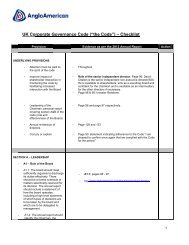Creating Value with the Future in Mind - Anglo American South Africa
Creating Value with the Future in Mind - Anglo American South Africa
Creating Value with the Future in Mind - Anglo American South Africa
You also want an ePaper? Increase the reach of your titles
YUMPU automatically turns print PDFs into web optimized ePapers that Google loves.
<strong>in</strong>vest<strong>in</strong>g <strong>in</strong> our people health<br />
health<br />
The issue<br />
Occupational health<br />
hazards have <strong>the</strong><br />
potential to harm<br />
employees if not<br />
managed properly.<br />
Failure to address <strong>the</strong>m<br />
is contrary to our<br />
commitment to zero<br />
harm and has a<br />
negative impact on<br />
productivity levels.<br />
Percentage reduction <strong>in</strong><br />
new cases of noise-<strong>in</strong>duced<br />
hear<strong>in</strong>g loss s<strong>in</strong>ce 2011<br />
28 %<br />
employees, <strong>the</strong>ir<br />
dependants and<br />
contractors participat<strong>in</strong>g<br />
<strong>in</strong> VCT dur<strong>in</strong>g 2012<br />
c.95,000<br />
Our strategy and<br />
management approach<br />
The crux of our occupational health<br />
strategy, and our entire focus on<br />
occupational health management, is<br />
<strong>in</strong>formed by <strong>the</strong> pr<strong>in</strong>ciple of prevention.<br />
We strive to proactively identify and<br />
manage <strong>the</strong> source of potential health<br />
risks, and to elim<strong>in</strong>ate exposure to<br />
hazards that can cause disease to<br />
develop. Our management approach<br />
is governed through a series of<br />
standards, guidel<strong>in</strong>es and assurance<br />
processes around two discipl<strong>in</strong>es:<br />
occupational hygiene and occupational<br />
medic<strong>in</strong>e. The former is about<br />
identify<strong>in</strong>g occupational exposure<br />
(to hazards), profil<strong>in</strong>g <strong>the</strong> associated<br />
risks, and controll<strong>in</strong>g exposure <strong>in</strong> <strong>the</strong><br />
workplace environment; <strong>the</strong> latter<br />
refers to monitor<strong>in</strong>g <strong>the</strong> health of<br />
employees. Our pr<strong>in</strong>cipal occupational<br />
health risks relate to noise, <strong>in</strong>halable<br />
hazards (ma<strong>in</strong>ly dust), and fatigue.<br />
Build<strong>in</strong>g on <strong>the</strong>se <strong>in</strong>itiatives is our<br />
employee health and wellness<br />
programme, which <strong>in</strong>cludes a strong<br />
emphasis on combat<strong>in</strong>g HIV/AIDS and<br />
tuberculosis (TB) <strong>with</strong><strong>in</strong> our workforce<br />
and <strong>the</strong>ir families. Beyond our<br />
immediate workforce, we believe that<br />
we must help streng<strong>the</strong>n healthcare<br />
systems <strong>in</strong> under-serviced rural areas<br />
and build partnerships to improve<br />
access to quality healthcare.<br />
Occupational health<br />
Our approach to manag<strong>in</strong>g<br />
occupational health is governed by<br />
<strong>the</strong> <strong>Anglo</strong> <strong>American</strong> Occupational<br />
Health Way. This is underp<strong>in</strong>ned by<br />
three guid<strong>in</strong>g pr<strong>in</strong>ciples:<br />
Implement<strong>in</strong>g simple,<br />
non-negotiable standards<br />
Dur<strong>in</strong>g <strong>the</strong> year, we educated<br />
managers on our noise and dust<br />
standards and <strong>the</strong> associated risk<br />
management programmes. These<br />
hear<strong>in</strong>g-conservation and respiratoryprotection<br />
standards, published last<br />
year as part of <strong>the</strong> Group Technical<br />
Standards, are be<strong>in</strong>g rolled out to <strong>the</strong><br />
bus<strong>in</strong>esses for implementation.<br />
Bus<strong>in</strong>esses have completed selfassessments<br />
aga<strong>in</strong>st <strong>the</strong> requirements<br />
of <strong>the</strong> noise and dust standards. By<br />
<strong>the</strong> end of 2012, our bus<strong>in</strong>ess units’<br />
average levels of compliance <strong>with</strong><br />
<strong>the</strong>se standards were between<br />
60% and 85%.<br />
We are putt<strong>in</strong>g renewed emphasis<br />
on fatigue management. On <strong>the</strong> health<br />
front, we are educat<strong>in</strong>g people on <strong>the</strong><br />
importance of gett<strong>in</strong>g a good night’s<br />
sleep, eat<strong>in</strong>g correctly, and report<strong>in</strong>g<br />
to work <strong>in</strong> a fit state. On <strong>the</strong> safety<br />
side, we recognise <strong>the</strong> need to design<br />
jobs so <strong>the</strong>y do not create fatigue,<br />
for <strong>in</strong>stance by ensur<strong>in</strong>g sufficient<br />
breaks, or through technology that<br />
will protect people if <strong>the</strong>y are tired.<br />
In 2012, we also re<strong>in</strong>vigorated our<br />
approach to fight<strong>in</strong>g alcohol and<br />
substance abuse <strong>in</strong> our workforce.<br />
We take a human-rights-based<br />
approach that focuses on prevention<br />
and rehabilitation, so that as far as<br />
possible problems are identified and<br />
dealt <strong>with</strong> long before discipl<strong>in</strong>ary<br />
measures are required.<br />
Total new cases of occupational<br />
disease and occupational disease<br />
<strong>in</strong>cidence rates 2008–2012<br />
Beyond our<br />
immediate<br />
workforce,<br />
we believe<br />
that we must<br />
help streng<strong>the</strong>n<br />
healthcare<br />
systems <strong>in</strong><br />
under-serviced<br />
rural areas<br />
and build<br />
partnerships<br />
to improve<br />
access to<br />
quality<br />
healthcare.<br />
••<br />
All occupational illnesses are<br />
preventable<br />
••<br />
We will learn by assess<strong>in</strong>g and<br />
monitor<strong>in</strong>g exposure and<br />
surveillance of disease <strong>in</strong>cidence<br />
<strong>in</strong> order to prevent fur<strong>the</strong>r harm<br />
••<br />
We apply common, simple and<br />
non-negotiable standards<br />
throughout <strong>the</strong> Group.<br />
500<br />
400<br />
300<br />
200<br />
100<br />
0.5<br />
0.4<br />
0.3<br />
0.2<br />
0.1<br />
0<br />
2008 2009 2010 2011 2012<br />
ODIR<br />
NCOD<br />
The significant <strong>in</strong>crease <strong>in</strong> new cases of<br />
occupational diseases reported <strong>in</strong> 2009 was a<br />
consequence of improved report<strong>in</strong>g between<br />
2008 and 2009. Detailed occupational health<br />
statistics are available <strong>in</strong> <strong>the</strong> appendix.<br />
0.0<br />
48 <strong>Anglo</strong> <strong>American</strong> plc Susta<strong>in</strong>able Development Report 2012


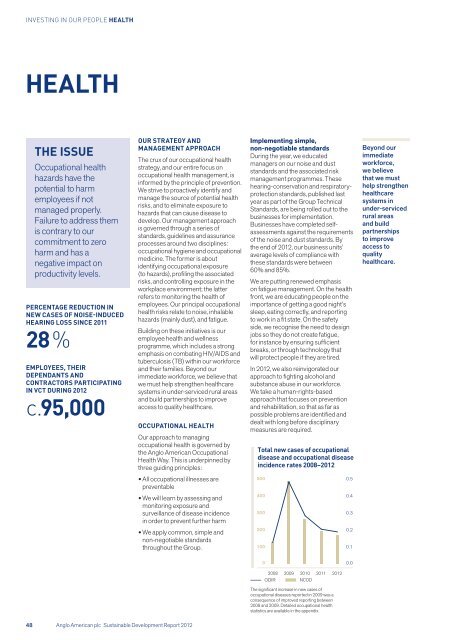
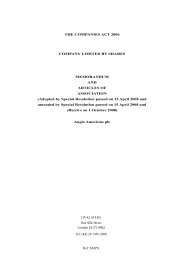
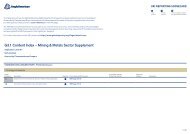
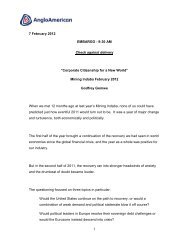
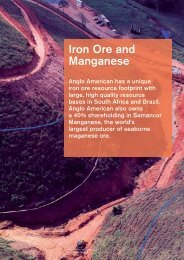
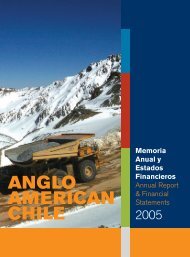
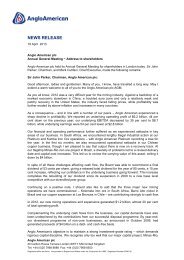
![English PDF [ 189KB ] - Anglo American](https://img.yumpu.com/50470814/1/184x260/english-pdf-189kb-anglo-american.jpg?quality=85)
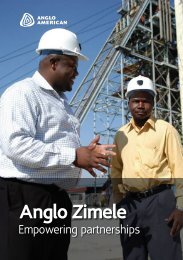

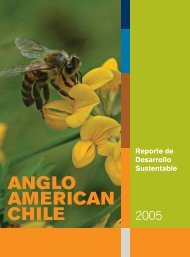

![pdf [ 595KB ] - Anglo American](https://img.yumpu.com/49420483/1/184x260/pdf-595kb-anglo-american.jpg?quality=85)
![pdf [ 1.1MB ] - Anglo American](https://img.yumpu.com/49057963/1/190x240/pdf-11mb-anglo-american.jpg?quality=85)
